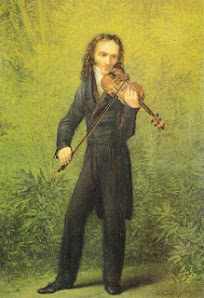One of the greatest treatises on music in the history of the violin is Niccolo Paganini's 24 Caprices for Solo Violin, which represents the pinnacle of the development of the instrument´s technique. Their impact reached even beyond the violin, inspiring composers like Chopin and Liszt, for example, to devise their respective Études for piano. Moreover, the technical feats that Niccolo lavished in his performances largely motivated Franz Liszt to replicate on the piano what the Italian master was doing on the violin.
Nor does he lack humor; years later, perhaps thinking of a later edition, he writes on the originals a note dedicating each Caprice to 23 fellow composers, among them Liszt, Vieuxtemps, Spohr, Thalberg, Kreutzer. But he has reserved Caprice No. 24 for himself, annotating after his name: "regrettably buried".
Caprice No. 24 in A minor
It is precisely Caprice No. 24 that attracted the attention of the public and authors of the time (also of our days), who, inspired by the piece, created a significant number of arrangements and variations for various instruments and instrumental ensembles. Among those arising in the 19th century, let us note: Rhapsody on a theme of Paganini by Rachmaninoff, Études on Paganini, by Liszt, also those of Schumann, the Variations on a theme of Paganini by Brahms. A long etcetera follows, conceived by less renowned authors. In our days, let us point out the jazzy arrangement by Benny Goodman.
Theme and variations
Marked quasi presto, the piece is less than five minutes long. Despite its short duration, it is constructed in the form of a theme and variations, exactly eleven variations, plus a finale. A wide variety of advanced, highly demanding techniques are present: very fast scales and arpeggios, double and triple trills, left-hand pizzicato, parallel octaves and tenths, rapid leaps, and string crossings... Nothing seems to be beyond the reach of the violinist who had a pact with the devil.
The rendition is by the Russian master Maxim Vengerov. Brilliant interpretation, although one must regret the liberties taken by the cameraman or the editor. Too many. One commenter on Youtube wonders if they might have been drunk.
